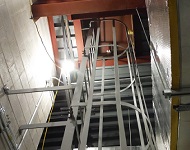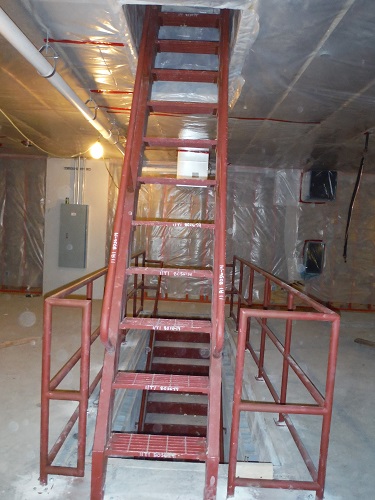
By Gregory Havel
Spaces that contain the mechanical “heart” of the building (heating, ventilating, air-conditioning, electric, and plumbing) are not considered as important by building owners as those spaces that earn revenue. As a result, these are often cramped rooms filled with machines, pipes, and ducts, with just enough room for a service technician in street clothes to enter with tools. These spaces are often located on mezzanines, in attics or truss lofts, and on roofs. The mechanical equipment is large, and is often set in place by crane while the building is under construction, before the roof and ceiling are installed, as the means of access to these spaces will not accommodate the physical size of the equipment.
Photo 1 shows a generous access stairway to a mechanical equipment room on a mezzanine in a school building.
(1) Photos by author.
Photo 2 shows a temporary construction stairway to provide access to one of the spaces for construction workers and which may remain for permanent access (or which may be replaced with a vertical ladder).
(2)
Photo 3 shows a space-saving adaptation of the stairway, sometimes called a “ship’s ladder.” This type of stairway has been in use in both steel and wooden ships for centuries as well as in buildings for decades.

(3)
Photo 4 shows a vertical ladder that is bolted to the wall for access to the mechanical space above.
(4)
Photo 5 shows a vertical ladder that is bolted to the wall which has a fall protection cage surrounding it because of the height of the ladder.
(5)
Since the equipment in mechanical spaces uses electricity, fuel (gas or combustible liquids), and heat, it is predictable that at some time there may be a fire or other incident requiring an emergency response. Since service personnel work in these spaces, it is predictable that at some time, someone will experience a medical emergency.
RELATED: Alvarez on Advancing a Hoseline Up Interior Stairs ‖ Avillo and Ricci on Moving a Downed Firefighter Up Stairs ‖ DiRenzo on Removing Firefighters Via Interior Stairs
The stairway in photo 1 provides the ease of access that is common between the floors in the occupied part of the building. Fire and emergency medical services (EMS) access is nearly unrestricted.
The stairway in photo 2 provides nearly the same ease of access, except that it is made of a combustible material, and will deteriorate more quickly from environmental conditions and age.
The ships ladder in photo 3 is narrow and steep; is designed for people in street clothes; and may be difficult to climb for a firefighter in full personal protective equipment (PPE) and carrying SCBA, hand tools, and a hoseline. Access may be difficult for EMS personnel with equipment bags and cases, and patient removal will also be very difficult.
The vertical ladder in photo 4 will require a firefighter to use both hands and both feet for climbing; and may require hoisting tools and hoselines with rope by someone already in the space above.
The vertical ladder in photo 5 has the same issues as the one in photo 4. However, the fall protection cage may make it impossible for most firefighters to climb in full PPE and SCBA.
In addition to limited access, these spaces usually have no windows or other ventilation openings to remove heat and other products of combustion. Removal of a patient by EMS can require technical rescue techniques since limited access also means limited means of egress.
Preplanning for a response to an incident in one of these spaces is essential for the protection of our emergency response personnel as well as for quality customer service.
Download this article as a PDF HERE (656 KB)
 Gregory Havel is a member of the Town of Burlington (WI) Fire Department; retired deputy chief and training officer; and a 35-year veteran of the fire service. He is a Wisconsin-certified fire instructor II, fire officer II, and fire inspector; an adjunct instructor in fire service programs at Gateway Technical College; and safety director for Scherrer Construction Co., Inc. Havel has a bachelor’s degree from St. Norbert College; has more than 35 years of experience in facilities management and building construction; and has presented classes at FDIC.
Gregory Havel is a member of the Town of Burlington (WI) Fire Department; retired deputy chief and training officer; and a 35-year veteran of the fire service. He is a Wisconsin-certified fire instructor II, fire officer II, and fire inspector; an adjunct instructor in fire service programs at Gateway Technical College; and safety director for Scherrer Construction Co., Inc. Havel has a bachelor’s degree from St. Norbert College; has more than 35 years of experience in facilities management and building construction; and has presented classes at FDIC.
MORE CONSTRUCTION CONCERNS

